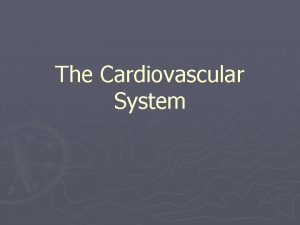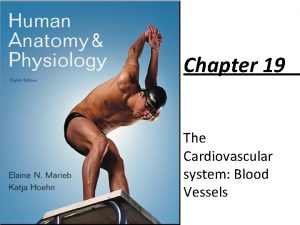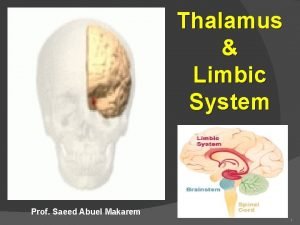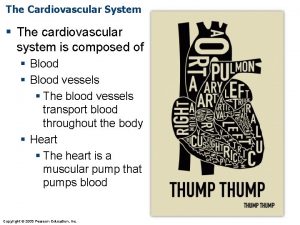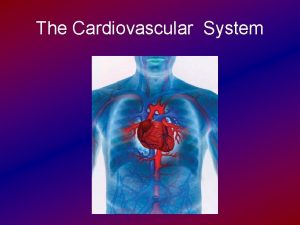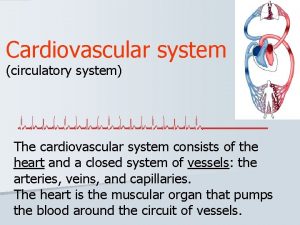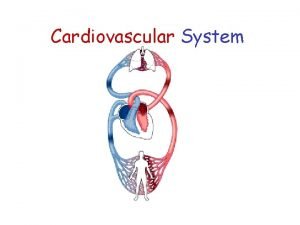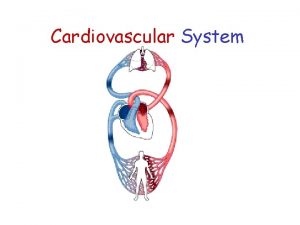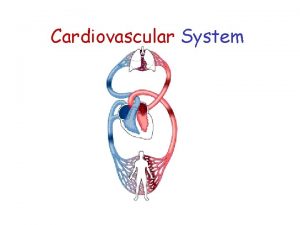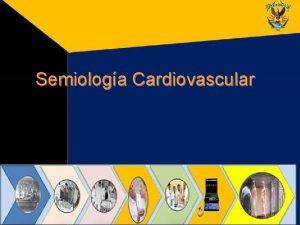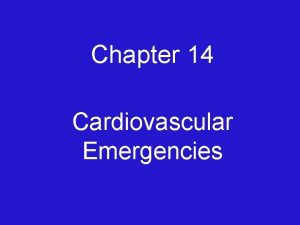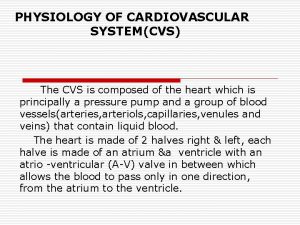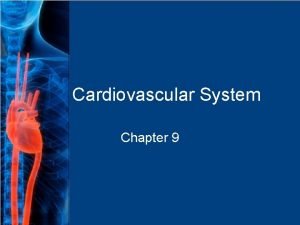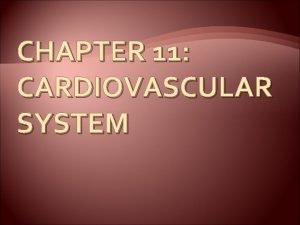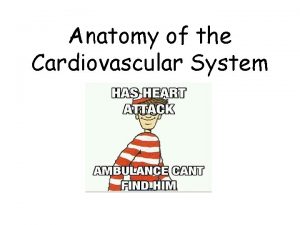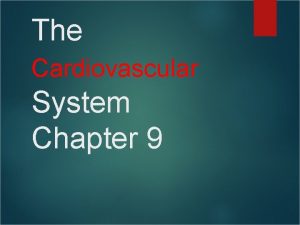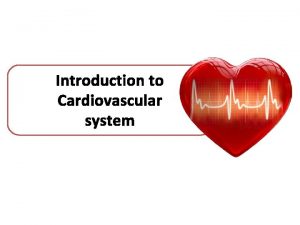The Cardiovascular System The Cardiovascular System Composed of





















- Slides: 21

The Cardiovascular System

The Cardiovascular System • Composed of: – Heart – Blood vessels – Blood • Functions: – Delivery of O 2, fuel, and nutrients to the tissues of the body – Removal of CO 2 and waste products from the tissues – Maintenance of a constant body temperature (thermoregulation) – Prevention of infection (immune function)

The Heart t Formed from myocardium, a specialized muscle tissue t Surrounded by pericardium (tough protective sac); allows heart to expand contract t Made up of four separate chambers: atria (upper chambers) and ventricles (lower chambers) t Considered a “double-pump” and is divided into the right and left heart; separated by the interventricular septum v. Right heart: } pumps deoxygenated blood to the lungs (pulmonary circulation) v. Left heart: } Pumps oxygenated blood to the rest of the body (systemic circulation)

The Internal Anatomy of the Heart Aorta Superior vena cava Right pulmonary artery Aortic semilunar valve Right pulmonary veins Pulmonary semilunar valve Right atrium Interventricular septum Left pulmonary artery Left pulmonary veins Left atrium Bicuspid (mitral) valve Left ventricle Chordae tendinae Tricuspid valve Papillary muscles Chordae tendinae Right ventricle Papillary muscles Inferior vena cava Thoracic aorta (descending)

Path of Blood Through the Heart Aorta Superior vena cava Right pulmonary artery Aortic semilunar valve Right pulmonary veins Pulmonary semilunar valve Right atrium Interventricular septum Left pulmonary artery Left pulmonary veins Left atrium Bicuspid (mitral) valve Left ventricle Chordae tendinae Tricuspid valve Papillary muscles Chordae tendinae Right ventricle Papillary muscles Inferior vena cava Thoracic aorta (descending)

Excitation of the Heart • • • Sinoatrial node (SA node): – Specialized region of tissue found in wall of right atrium – Location where electrical signals are initiated (“pacemaker”) Atrioventricular node (AV node): – Passes electrical signal from atria into ventricles – Passes electrical signal to the bundle of His (atrioventricular bundle) Bundle of His pass electrical signal to the Purkinje fibres pass electrical signal to the myocardium (heart tissue) The myocardium contract – Leads to contraction of the heart – Leads to the pumping of blood

The Electrical Activity of the Heart • Measured using an electrocardiogram (ECG) – Graphical representation of electrical sequence of events occurring with each contraction of the heart – Each wave generated during contraction is named: • P wave: represents depolarization through the atria • QRS complex: represents depolarization of the ventricle • T wave: represents repolarization of the ventricle

Coronary Vessels – Anterior View Anterior interventricular branch of left coronary artery Right coronary artery Small cardiac vein Great cardiac vein

Cardiac Cycle • Cardiac cycle: series of events occurring through one heartbeat • Involves two phases: v Diastole phase (relaxation) 4 Heart fills with blood v Systole phase (contraction) 4 Heart contracts and ejects blood

Cardiovascular Dynamics • • Cardiovascular system adapts to meet the demands that are placed on it Heart adjusts amount of blood pumped by altering: – Heart rate (HR) (beats/min) • duration of each cardiac cycle – Stroke volume(SV) (m. L) • volume of blood ejected by left ventricle per beat – Cardiac output (Q) (L/min) • HR SV = Q • The volume of blood pumped out of left ventricle in 1 min Frank-Starling Law: – Ability of the heart to stretch and increase the force of contraction Ejection fraction – Measure of stroke volume calculated by use of a formula

Blood Pressure • Blood Pressure is the force exerted by the blood against the walls of the arteries • Measuring blood pressure: systolic pressure over diastolic pressure – Systolic blood pressure: • Pressure observed in the arteries during contraction phase – Diastolic blood pressure: • Pressure observed in the arteries during relaxation phase of the heart

Normal Blood Pressure • Normal blood pressure (BP): 120 mm. Hg over 80 mm. Hg • Hypertension – BP greater than 140 mm. Hg over 90 mm. Hg • Factors affecting BP – Diet – Aerobic exercise

Blood Flow Distribution

Effects of Training

The effects of training on the heart • Regular aerobic exercise leads to alterations of the cardiovascular system • These are functional and structural – With exercise the size and mass of heart increase • Ventricular walls become thicker and volume of ventricle increases (due to increase in venous return) • This leads to a more forceful contraction= increase in stroke volume= increase in cardiac output

Bradycardia • Defined as: HR of less than 60 beats/minute at rest • Maximal HR stays more or less the same • Therefore there is an increase in exercise capacity in a trained individual • Most easily observed adaptation to the cardiovascular system

The Vascular System and Blood • Vascular System: – A network of vessels that transport blood throughout the body; vessels divided into four main categories: • Arteries: carry blood away from the heart to different organs • Arterioles: regulate blood distribution to various tissues of the body • Capillaries: responsible for the exchange of gases and nutrients with the tissues • Veins (venules): return blood to the heart

Summary of the Vascular System Large veins Medium veins Large arteries Medium arteries Arteriole Venules Capillary bed Capillaries Precapillary sphincters

The Return of Blood from the Veins • The skeletal muscle pump: – Upon contraction of skeletal muscle, blood is pushed/ massaged back to the heart • The thoracic pump: – Pressure in veins (in the chest) decrease while pressure in veins (in the abdominal cavity) increase upon intake of breath – Difference in pressure pushes blood from veins in the abdominal cavity into veins in the thoracic cavity • The nervous system: – Sends a signal to veins – Veins constrict allowing more blood back to the heart The skeletal muscle pump

Properties of Blood • Two main components: – Plasma • Fluid component of blood (mostly water) – Blood cells • Red blood cells (erythrocytes) – Made in bone marrow – Transport O 2 and CO 2 in the blood – Transport nutrients and waste – Contain hemoglobin • White blood cells (leukocytes) – Destroy foreign elements Plasma 55% 90% water 7% plasma proteins 3% other (acids, salts) Formed elements 45% >99% red blood cells <1% white blood cells and platelets

The effect of training on the vascular • Increase in number of capillaries that deliver blood to the heart tissue • Possible increase in the diameter of the coronary arteries increase in O 2 to the heart in order to work harder • Increase in blood volume up to 15% within 2 days • This causes increase in venous return= increase in stroke volume= increase in cardiac output
 Capillary bed
Capillary bed What makes up the circulatory system
What makes up the circulatory system Pithed model
Pithed model Cardiovascular/lymphatic system it's totally tubular
Cardiovascular/lymphatic system it's totally tubular Circulatory system crash course
Circulatory system crash course Chapter 5 learning exercises medical terminology
Chapter 5 learning exercises medical terminology Figure 11-7 veins labeled
Figure 11-7 veins labeled Figure 11-14 is a diagram of a capillary bed
Figure 11-14 is a diagram of a capillary bed Lesson 11 cardiovascular system
Lesson 11 cardiovascular system Lesson 11 cardiovascular system
Lesson 11 cardiovascular system Tissue in cardiovascular system
Tissue in cardiovascular system Anatomy blood vessels
Anatomy blood vessels Introduction to cardiovascular system
Introduction to cardiovascular system Cardiovascular system
Cardiovascular system Anatomy and physiology unit 7 cardiovascular system
Anatomy and physiology unit 7 cardiovascular system Cardiovascular system diseases and disorders chapter 8
Cardiovascular system diseases and disorders chapter 8 Chapter 13 cardiovascular system
Chapter 13 cardiovascular system Chapter 11 the cardiovascular system figure 11-2
Chapter 11 the cardiovascular system figure 11-2 The cardiovascular system includes the
The cardiovascular system includes the Blood vesel
Blood vesel True capillaries
True capillaries Limbic system 中文
Limbic system 中文


















